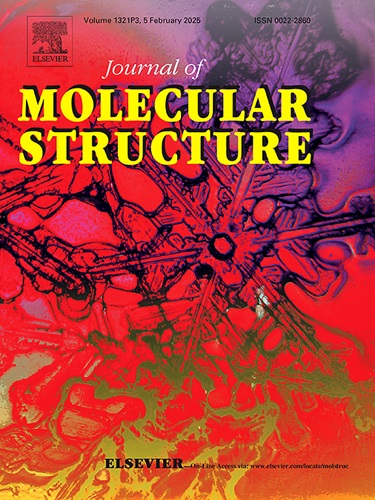Investigation of DNA binding and antibacterial properties of a Zn(II) Complex with an N2OS Salophen-type Ligand
IF 4
2区 化学
Q2 CHEMISTRY, PHYSICAL
引用次数: 0
Abstract
The platinum-based medication now used in chemotherapy has serious side effects, which has led to a lot of research into finding new coordination molecules with anticancer properties. To discover a new coordination complex, an unsymmetrical N2OS Salophen-type ligand was created. ZnCl2 and ligand were combined in a 1:1 molar ratio to yield the new Zn(II) complex. To analyze the synthesized ligand and Zn(II) complex, a variety of spectroscopic methods were employed, including NMR, UV–Vis, mass spectrometry, IR, and elemental analysis. The stability of the Zn(II) complex was also revealed by analyzing several electronic properties of its optimized structure using Density Functional Theory (DFT). As indicated by the molar conductance value the existence of chlorine as a counter ion to stabilize the complex suggests that the synthesized Zn(II) complex was electrolytic in nature. The interaction between Zn(II) complex and DNA has been studied using CT-DNA. The techniques employed in the study of DNA interaction included absorption, fluorescence, thermal denaturation, viscosity etc. All the methods confirmed that the Zn(II) complex exhibited excellent DNA binding. The ligand and Zn(II) complex's biological impact was also anticipated using SwissADME analysis. An in vitro antibacterial activity of the ligand (L2) and Zn(II) complex was conducted using strains of Staphylococcus aureus, Bacillus subtilis, Klebsiella pneumoniae, and Escherichia coli. Molecular docking studies were used to further support the earlier finding.

与 N2OS Salophen 型配体的 Zn(II) 复合物的 DNA 结合力和抗菌特性研究
目前用于化疗的铂基药物有严重的副作用,这导致了大量研究,以寻找具有抗癌特性的新配合分子。为了发现一个新的配位配合物,我们建立了一个不对称的N2OS salophen型配体。ZnCl2和配体以1:1的摩尔比结合得到新的Zn(II)配合物。为了分析合成的配体和Zn(II)配合物,采用了多种光谱分析方法,包括核磁共振、紫外-可见、质谱、红外和元素分析。利用密度泛函理论(DFT)分析了Zn(II)配合物优化结构的若干电子性质,揭示了其稳定性。从摩尔电导值可以看出,氯作为反离子的存在使配合物稳定,表明合成的Zn(II)配合物本质上是电解的。利用CT-DNA研究了Zn(II)配合物与DNA的相互作用。用于DNA相互作用研究的技术包括吸收、荧光、热变性、粘度等。所有方法均证实Zn(II)配合物具有良好的DNA结合性能。配体和锌(II)配合物的生物学影响也预测使用SwissADME分析。用金黄色葡萄球菌、枯草芽孢杆菌、肺炎克雷伯菌和大肠杆菌等菌株对该配体(L2)和Zn(II)配合物进行了体外抑菌活性研究。分子对接研究被用来进一步支持早期的发现。
本文章由计算机程序翻译,如有差异,请以英文原文为准。
求助全文
约1分钟内获得全文
求助全文
来源期刊

Journal of Molecular Structure
化学-物理化学
CiteScore
7.10
自引率
15.80%
发文量
2384
审稿时长
45 days
期刊介绍:
The Journal of Molecular Structure is dedicated to the publication of full-length articles and review papers, providing important new structural information on all types of chemical species including:
• Stable and unstable molecules in all types of environments (vapour, molecular beam, liquid, solution, liquid crystal, solid state, matrix-isolated, surface-absorbed etc.)
• Chemical intermediates
• Molecules in excited states
• Biological molecules
• Polymers.
The methods used may include any combination of spectroscopic and non-spectroscopic techniques, for example:
• Infrared spectroscopy (mid, far, near)
• Raman spectroscopy and non-linear Raman methods (CARS, etc.)
• Electronic absorption spectroscopy
• Optical rotatory dispersion and circular dichroism
• Fluorescence and phosphorescence techniques
• Electron spectroscopies (PES, XPS), EXAFS, etc.
• Microwave spectroscopy
• Electron diffraction
• NMR and ESR spectroscopies
• Mössbauer spectroscopy
• X-ray crystallography
• Charge Density Analyses
• Computational Studies (supplementing experimental methods)
We encourage publications combining theoretical and experimental approaches. The structural insights gained by the studies should be correlated with the properties, activity and/ or reactivity of the molecule under investigation and the relevance of this molecule and its implications should be discussed.
 求助内容:
求助内容: 应助结果提醒方式:
应助结果提醒方式:


